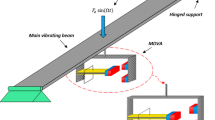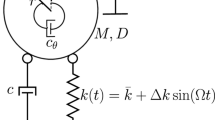Abstract
The acoustic characteristics of a dual Helmholtz resonator in the presence of flow is investigated theoretically and experimentally. A lumped parameter model is introduced, including the damping effect and neck inertia, and the predicted transmission loss (TL) is compared with experiments performed with a flow-impedance tube setup. ^Predicted and measured results with flow exhibit a good agreement, while capturing the key variations in peak TL magnitude and the shifts in peak TL frequency. Theoretical approach demonstrates that the damping of the first neck inertia of the dual Helmholtz resonator has a marked impact not only on the magnitude of the first peak TL but also the second peak TL.
Similar content being viewed by others
Abbreviations
- M1, M2 :
-
Air mass in the first and second HR necks
- x1, x2 :
-
Displacement of the air mass of the first and second HR neck
- F i :
-
Input force to the dual Helmholtz resonator
- AC1, AC2 :
-
Cross-sectional area of the first and second neck
- ρ 0 :
-
Air density
- c 0 :
-
Speed of sound
- V1, V2 :
-
First and second HR cavity volume
- R1, R2 :
-
Damping of the first and second HR
- X j :
-
Magnitude of the displacement in complex number (j = 1,2)
- S d :
-
Cross-sectional area of the main duct
- Rac1′, Rac2′:
-
Dimensionless acoustic impedances
- U 1 :
-
Volume velocity at the first HR neck
- Au, Ad :
-
Incident and transmitted waves
- I eff :
-
Effective neck length
- Ma :
-
Mach number scale
References
L. E. Kinsler et al., Fundamentals of Acoustics, 4th ed., John Wiley and Sons, Inc., New York (1999).
R. L. Panton and J. M. Miller, Resonant frequencies of cylindrical Helmholtz resonators, J. Acoust. Soc. Am., 57 (6) (1975) 1533–1535.
S. K. Tang, On Helmholtz resonators with tapered necks, J. Sound Vib., 279 (3-5) (2005) 1085–1096.
A. Selamet and P. M. Radavich, Circular concentric Helmholtz resonators, J. Acoust. Soc. Am., 101 (1) (1997) 41–51.
A. Selamet and Z. L. Ji, Circular asymmetric Helmholtz resonators, J. Acoust. Soc. Am., 107 (2000) 2360–2369.
A. Selamet and I. Lee, Helmholtz resonator with extended neck, J. Acoust. Soc. Am., 113 (4 Pt 1) (2003) 1975–1985.
A. Selamet et al., Helmholtz resonator lined with absorbing material, J. Acoust. Soc. Am., 117 (2) (2005) 725–733.
M. B. Xu, A. Selamet and H. Kim, Dual Helmholtz resonator, Appl. Acoust, 71 (9) (2010) 822–829.
L. J. Sivian, Acoustic impedance of small orifices, J. Acoust. Soc. Am., 7 (1935) 94–101.
R. F. Lambert, Acoustic fintering in a moving medium, J. Acoust. Soc. Am., 28 (1956) 1054–1058.
R. F. Lambert, Side branch insertion loss in a moving medium, J. Acoust. Soc. Am., 28 (1956) 1059–1063.
E. Meyer, F. Mechel and G. Kurtze, Experiments on the influence of flow on sound attenuation in absorbing ducts, J. Acoust. Soc. Am., 30 (1958) 165–174.
K. J. Baumeister and E. J. Rice, Visual study of the effect of grazing flow on the oscillatory flow in a resonator orifice, NASA Report TM X-3288 (1975).
B. E. Walker and A. F. Charwat, Correlation of the effects of grazing flow on the impedance of Helmholtz resonators, J. Acoust. Soc. Am., 72 (2) (1982) 550–555.
B. Philips, Effects of high-wave amplitude and mean flow on a Helmholtz resonator, NASA Report TMX-1582 (1968).
A. Hersch and B. Walker, Effect of grazing flow on the acoustic impedance of Helmholtz resonators consisting of single and clustered orifices, NASA Contractor Report 3177 (1979).
H. Kim and A. Selamet, Acoustic performance of a Helmholtz resonator with flow, Int. J. Veh. Noise Vib., 7 (4) (2011) 285–305.
E. Selamet et al., Acoustics of a Helmholtz resonator aligned parallel with flow: A computational study vs experiments, Int. J. Mater. Mech. Manuf., 1 (2) (2013) 210–213.
H. Kim, Transmission loss of silencers with flow from a flow-impedance tube using burst signals, Doctorial Thesis, The Ohio State University (2011).
J. Y. Chung and D. A. Blaser, Transfer function method of measuring in-duct acoustic properties. I. Theory, J. Acoust. Soc. Am., 68 (3) (1980) 907–913.
J. Y. Chung and D. A. Blaser, Transfer function method of measuring in-duct acoustic properties. II. Experiment, J. Acoust. Soc. Am., 68 (3) (1980) 914–921.
A. F. Seybert and D. F. Ross, Experimental determination of acoustic properties using a two-microphone random-excitation technique, J. Acoust. Soc. Am., 61 (5) (1977) 1362–1370.
Author information
Authors and Affiliations
Corresponding author
Additional information
Recommended by Editor No-cheol Park
Hyunsu Kim, Ph.D., received his doctor degree at the Ohio State University in 2011 after achieving B.S. from Kookmin University in 2001 and M.S. from University of Cincinnati in 2006. His research area is acoustics of intake/exhaust system especially focusing on nonlinear characteristics in silencers in the presence of flow. From 2011 to 2016, he worked at Hyundai-Kia Motor Company as a Senior Researcher in the power-train NVH team expanding his area of interest to (hybrid) electrical vehicle motor noise. He is currently an Assistant Professor at the Mechanical, Automotive and Robot Component Engineering Department in Dong-eui University in South Korea.
Ahmet Selamet received his Ph.D. in Mechanical Engineering from University of Michigan in 1989. He joined the Mechanical Engineering Department of Ohio State University (OSU) in 1996, where he holds the rank of Professor since 2001. His research centers around internal combustion engines, linear/nonlinear wave dynamics, noise/pollutant emission control, fluid mechanics, combustion, and heat transfer. He has published more than 215 articles in journals and proceedings. His recognitions include Harrison, Lumley, and MacQuigg Awards from OSU; and Teetor Award and Ralph K. Hillquist NVH Lifetime Achievement Award from the Society of Automotive Engineers (SAE). He has been elected a Fellow of the Acoustical Society of America and SAE.
Rights and permissions
About this article
Cite this article
Kim, H., Selamet, A. Effect of flow on a dual Helmholtz resonator. J Mech Sci Technol 34, 581–588 (2020). https://doi.org/10.1007/s12206-020-0106-7
Received:
Revised:
Accepted:
Published:
Issue Date:
DOI: https://doi.org/10.1007/s12206-020-0106-7




